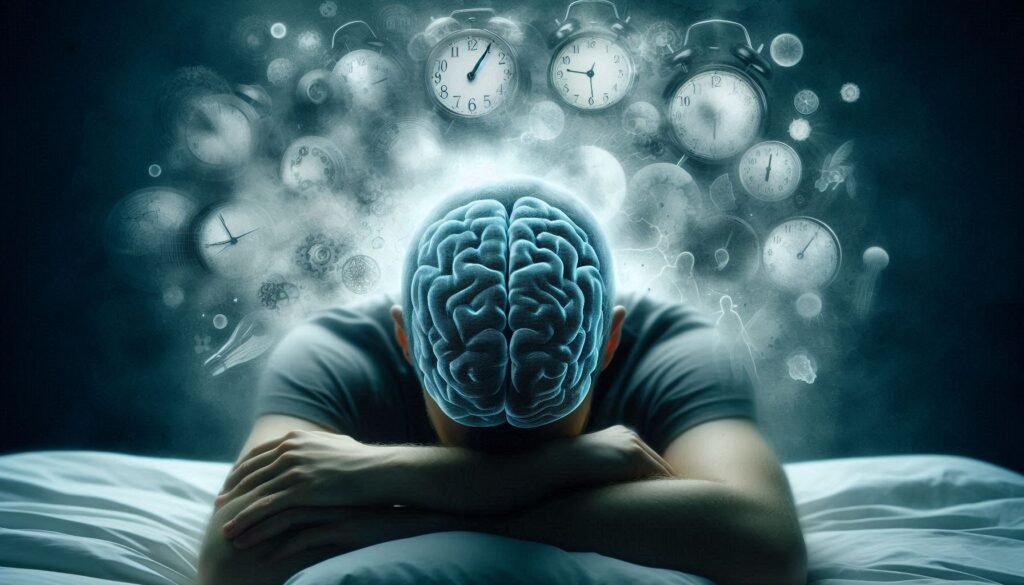Sleep is a vital component of our overall well-being, yet many people overlook its profound impact on mental health conditions. Among these is catatonia—a complex state characterized by stupor, rigidity, and unusual motor behavior. Recent research has spotlighted the intricate relationship between sleep disorders and catatonic states, revealing how disturbances in sleep can exacerbate or even trigger these symptoms.
Understanding this connection opens new doors for treatment and management strategies. As we delve into the various types of sleep disorders affecting those with catatonia—from insomnia to REM Sleep Behavior Disorder—we’ll uncover the neurobiological links that tie them together. Join us as we explore how addressing sleep issues can lead to better outcomes for individuals facing the challenges of catatonia.

Sleep Disturbances in Catatonia: An Overview
Catatonia is often depicted as a state of unresponsiveness or abnormal motor behavior. However, it encompasses a broader spectrum of symptoms that can significantly impact an individual’s daily life. One critical aspect of catatonia that has garnered attention is its association with sleep disturbances.
Many individuals with catatonic features report experiencing various sleep-related issues, which can complicate their overall condition. Sleep disturbances are not merely secondary effects; they may play a crucial role in the onset and persistence of catatonic symptoms.
Research indicates that insomnia, hypersomnia, and other sleep disorders may exacerbate the severity of catatonias like stupor and immobility. This relationship underscores the need for comprehensive assessments focusing on both mental health and sleep quality when addressing catatonic states.
Understanding these connections sheds light on potential treatment options that prioritize improving sleep hygiene as part of managing catatonia effectively. Addressing these disruptions might pave the way for better therapeutic interventions tailored to individual needs.
Insomnia and Its Relationship to Catatonic Symptoms
Insomnia is a prevalent sleep disorder characterized by difficulty falling or staying asleep. This condition can significantly impact mental health, often exacerbating existing psychiatric issues. For individuals experiencing catatonic symptoms, insomnia presents unique challenges that may intensify their overall condition.
Research suggests that the stress and anxiety associated with insomnia can trigger or worsen catatonia. The inability to obtain restful sleep leads to fatigue and irritability, which are common in those displaying catatonic features. These individuals might exhibit reduced responsiveness or unusual postures as their bodies struggle to cope.
Furthermore, disrupted sleep patterns affect cognitive functioning. Poor sleep quality can impair judgment and decision-making abilities in patients prone to catatonia. This connection highlights the importance of addressing insomnia when managing these complex symptoms.
Therapeutic interventions targeting both insomnia and underlying psychological conditions could be vital for improving patient outcomes. Understanding this relationship between insomnia and catatonic states is crucial for effective treatment strategies moving forward.
Hypersomnia and Catatonic Presentations
Hypersomnia is characterized by excessive daytime sleepiness and prolonged nighttime sleep. This disorder can severely impact daily functioning, leading to challenges in maintaining alertness. In individuals experiencing catatonia, hypersomnia may present as a profound lack of response or unusual tranquility.
Research indicates that some people with catatonia exhibit signs of hypersomnia, which complicates the clinical picture. These patients might alternate between episodes of extreme lethargy and periods where they display more obvious symptoms associated with catatonic states—such as immobility or mutism.
The relationship between hypersomnia and catatonic presentations highlights the complexity of these conditions. Understanding this interplay is crucial for accurate diagnosis and effective treatment strategies.
Treatment options often need to address both the underlying causes of hypersomnia and its effects on catatonic features. By improving sleep quality and duration, clinicians may help alleviate some aspects of the patient’s overall condition while enhancing their responsiveness to therapy.
Circadian Rhythm Disorders and Catatonia Risk
Circadian rhythm disorders disrupt the body’s natural sleep-wake cycle. This misalignment can influence mental health significantly, potentially increasing the risk of catatonia. When an individual experiences irregular sleep patterns, it may lead to heightened stress and anxiety levels.
Research suggests that individuals with disrupted circadian rhythms are more susceptible to mood disorders, which can exacerbate catatonic symptoms. The connection between these two conditions is complex but critical for understanding patient care strategies.
Moreover, people suffering from chronic circadian disruptions often experience fatigue and cognitive impairments. These issues can manifest as withdrawal or unresponsiveness—key features of catatonic states.
Addressing circadian rhythm disturbances may play a vital role in managing catatonia effectively. A focus on improving sleep hygiene and establishing consistent routines could offer promising avenues for reducing risk factors associated with this challenging condition.
Sleep Apnea’s Impact on Catatonic States
Sleep apnea is a common sleep disorder characterized by repeated interruptions in breathing during sleep. This condition can lead to significant daytime fatigue and cognitive impairment, which may exacerbate catatonic states. Individuals experiencing both disorders often find their symptoms intertwined, complicating treatment approaches.
In catatonia, patients may exhibit a range of behaviors such as immobility or excessive motor activity. Research indicates that the fragmented sleep caused by sleep apnea might contribute to these abnormal presentations. The disordered breathing disrupts REM cycles—crucial for mental health—potentially leading to an increase in emotional dysregulation.
Furthermore, untreated sleep apnea can result in chronic stress on the body and brain. Chronic stress has been linked with various psychiatric conditions, including those associated with catatonia. As individuals struggle with sleeplessness and exhaustion, their vulnerability to developing more severe catatonic features increases.
Addressing sleep apnea could significantly improve outcomes for those experiencing catatonic states. Effective interventions might reduce symptom severity and enhance overall functioning through better-quality rest.
Narcolepsy and Catatonia: Exploring the Connection
Narcolepsy is a chronic sleep disorder characterized by excessive daytime sleepiness and sudden sleep attacks. These episodes can manifest unpredictably, impacting daily functioning significantly. Interestingly, narcolepsy may share some overlapping features with catatonia, leading to an intriguing connection worth exploring.
Individuals experiencing both conditions might present similar symptoms such as altered consciousness or motor activity changes. This resemblance complicates accurate diagnosis and treatment strategies. While narcoleptics often struggle with maintaining alertness during the day, they could exhibit catatonic-like states when transitioning between wakefulness and sleep.
The neurobiological underpinnings of these disorders also warrant attention. Both involve disruptions in neurotransmitter systems that regulate arousal and mood. The interplay between REM sleep disturbances seen in narcolepsy and the emotional dysregulation observed in catatonia highlights this potential link further.
Understanding how narcolepsy influences or coexists with catatonia is essential for clinicians striving to provide effective treatment plans tailored to individual patient needs. More research is necessary to clarify this complex relationship fully.
REM Sleep Behavior Disorder and Catatonic Features
REM Sleep Behavior Disorder (RBD) is characterized by the enactment of dreams, often resulting in physical movements during REM sleep. Individuals with RBD may experience vivid and intense dreams that lead to violent or chaotic behaviors while they are still asleep. This disorder can disrupt both their own sleep and the sleep of those around them.
Research suggests a potential overlap between RBD and catatonic features. Some patients exhibiting catatonia display unusual motor patterns reminiscent of the movements associated with RBD. These manifestations raise intriguing questions about underlying neurobiological connections.
Moreover, individuals suffering from both conditions may present unique challenges for diagnosis and treatment. The presence of catatonic symptoms alongside RBD can complicate clinical assessments, as traditional indicators might be masked or altered.
Understanding these relationships could pave the way for more effective interventions targeting both disorders simultaneously, enhancing patient care outcomes significantly over time.
Neurobiological Links Between Sleep and Catatonia
Recent research has revealed significant neurobiological links between sleep disorders and catatonic states. The brain’s intricate systems governing sleep are also involved in regulating mood and motor functions, both of which can be disrupted in catatonia.
Dysregulation of neurotransmitters is a key factor. For instance, abnormalities in dopamine pathways have been implicated in both sleep disturbances and catatonic symptoms. This suggests that the biological processes affecting our ability to sleep may also precipitate or exacerbate catatonia.
Additionally, alterations in circadian rhythms can profoundly affect mental health. Disruption of these rhythms may lead to increased vulnerability for individuals already at risk for developing catatonic features.
Studies show that inflammation is another critical player linking poor sleep quality with heightened susceptibility to psychiatric conditions like catatonia. Understanding these connections could pave the way for targeted therapies aimed at improving both sleep patterns and overall mental health outcomes for those affected by this complex disorder.
Diagnosing Sleep-Related Catatonia
Diagnosing sleep-related catatonia requires a comprehensive approach. Clinicians must first conduct thorough interviews to collect detailed patient histories, focusing on sleep patterns and any existing mental health conditions. This helps establish a baseline for understanding the individual’s overall state.
A physical examination is also essential. Doctors will assess neurological function and look for signs of catatonic behavior, such as immobility or unusual posturing. Observations during different times of day can provide insights into how sleep disturbances affect motor functions.
Sleep studies may be necessary to evaluate specific disorders like insomnia or obstructive sleep apnea. These assessments help determine if disrupted sleep contributes to the patient’s catatonic symptoms.
Collaboration between psychiatrists and sleep specialists can enhance diagnostic accuracy. Together, they can develop tailored treatment plans that address both the psychiatric aspects and underlying sleep disorders contributing to catatonia.
Sleep Interventions in Catatonia Management
Addressing sleep disorders in the context of catatonia is essential for effective management. Several interventions can improve both sleep quality and catatonic symptoms, providing a dual benefit for affected individuals.
Cognitive Behavioral Therapy for Insomnia (CBT-I) stands out as a first-line treatment. This structured program helps patients identify and change thoughts or behaviors that negatively affect their sleep. Additionally, mindfulness practices can enhance relaxation and reduce anxiety, contributing to better sleep patterns.
Pharmacological treatments may also play a role. Medications like benzodiazepines or certain antidepressants can help regulate sleep cycles when prescribed by psychiatrists experienced in managing catatonia.
Non-invasive therapies such as light therapy are gaining attention too. They help reset circadian rhythms, particularly beneficial for those with rhythm-related disturbances.
Regular monitoring and follow-up are vital components of any intervention plan. Tailoring approaches to individual needs ensures better outcomes in treating both the underlying sleep disorder and its impact on catatonic states.
Through these combined efforts, we can significantly mitigate the effects of sleep disorders on individuals experiencing catatonia while promoting overall mental health stability.


